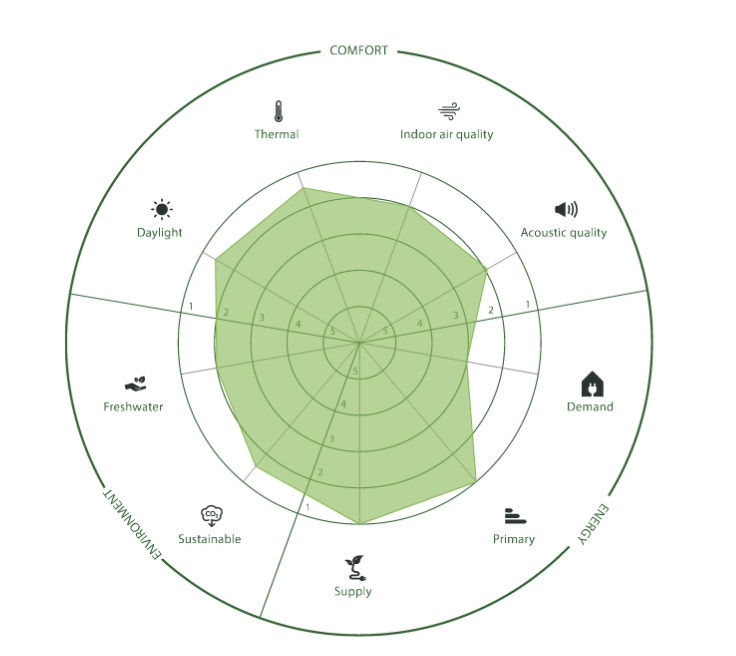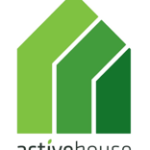017 Bouw•Novum 5.4 woning
Location: Bremweg 14-24, Nijverdal, Netherlands
Owner/investor: –
Architects: Bouw•Novum B.V.
Project type: House

Our house has been designed from the comfort of the residents, one of the Active House principles,in which energy and the environment are certainly not overlooked. People-centred, and finally ableto live and live consciously!
An essentially different vision and approach than is currently taking place in the current traditional market, in which the focus is gradually being expanded from energy to include the environment, but in which no attention is yet paid to comfort.
With regard to daylight, a maximum daylight level has been chosen. Façade openings with the right dimensions in the right positions ensure this, whereby sun protection prevents heating during warm periods. A unique solar chimney, with VELUX roof windows, provides extra daylight in all living areas, even in the heart of the house (see also the attached photos).
The right, bio-based insulation, in which the insulation value is in balance with the environmental impact, prevents heating of the fully wooden house in the summer months. During prolonged warm periods, heating of the house cannot be prevented with this insulation alone. In addition to the aforementioned sun protection, the solar chimney plays a major role in thermal comfort in the summer months, and together they prevent heat stress in the home. Ventilation hatches are included in the façade, which, together with the VELUX windows that canbe opened, are used for intensive and natural summer evening and night cooling. This combination works so well that we achieved a TO-July score, which is an indicator added to the energy performance calculation (NZEB), of 0.00!
Natural ventilation is also possible in all seasons with the solar chimney and ventilation hatches.The rise of warm air in the solar chimney ensures the transport and removal of polluted air. In those parts of the season where natural ventilation is not comfortable, a
zonal and demand-driven ventilation system,based on CO₂ detection, takes over the ventilation from DUCO.
The fresh outside air is drawn in by specially developed electronic grilles, guided along the ceiling, where it mixes with warm air. This is the so-called adhesive effect, which means that the outside air never sinks down like a cold blanket and comfort is guaranteed. Due to the CO₂ detection in all living areas, this installation is used as little as necessary, so that we can ventilate as much as possible naturally all year round.
By using a fully wooden shell and facade-filling elements, no emissions of volatile substances take place in the house and a very healthy, the vapour-permeable building envelope has been achieved. This is airtight for calculation of heat losses and drafts, but with the addition of controllable ventilation for periods when this is comfortable.

When designing the applied energy concept, we have achieved an optimal balance between energy consumption, i.e. heat losses, and thermal comfort in the home. But we have always kept the focus on limited use of raw materials. We therefore deliberately do not use the Passive House principles, where small facade openings, a heavily insulated outer shell and balanced ventilation are common.
The enormous energy savings can be found in natural ventilation and cooling, limited use of the ventilation system, optimum building envelope and orientation on the plot and insulating compartments in residential areas. For example, the ground floor and the bathroom on the first floor are only heated. All other rooms can be heated by using IR heating, but are not heated as standard. An extra layer of insulation in the first floor means that only the ground floor needs to be heated and unnecessary heat losses are prevented. Unfortunately, these unique solutions do not (yet) affect the outcome of the available Uniec 3.0 calculation. Despite this limitation, our property is ENG. This means that the house is energy neutral and itself provides for all building-related energy consumption (heating, cooling, ventilation, hot tap water).

The house has a fully wooden hull and façades. The demountable homes can be easily expanded/included as required, which prevents the occupation of a 1-2 person household in a single-family home and prevents the construction of unnecessarily large homes. This also prevents unnecessary use of building materials. The house has an Environmental Performance Building score of € 0.43 (these are shadow costs per year per m²gross floor area), and 209,812 kg CO2 has been recorded in the shell of the 6 pilot houses alone. It consists of a combination of CLT (Cross Laminated Timber) for the supporting structure and facade-filling elements of timber frame construction.
Due to a decoupled construction, the CLT hull is completely separated from each other and can be reused endlessly. So no CO₂ back into the atmosphere, no over-exploitation on the earth, no pollution and therefore no interventions on climate/nature.
The design is bio-inspired based on the 3 core elements: Ethos; sense of responsibility,(re)connect; humans and nature intertwined and emulate; nature as a source of inspiration. The house has minimal impact on climate and nature during the life cycle and has a high degree of circularity through maximum reuse of elements without having to separate them from each other. As described under ‘energy’, we really opt for limited use of materials and these materials are in any case regrowthable, re-used or recycled.
We leave the bottom completely untouched. At the end of the life of the house, the soil is easily delivered in its original condition.
The house is characterized by elementary construction, instead of building in modules. As a result, we do not transport air and we only have a limited number of transport movements. By way of comparison: an identical house in modules is transported in 5 to 6 loads, while our house only has 2 loads to the construction site. There is low nitrogen emissions for the realization because we do not have our own factory, but use full prefabrication by market parties near the construction site, anywhere in the Netherlands. Sowe don’t know of endless national transports that do involve delivery from our own factory.
Our house has very limited CO₂ emissions during the life cycle, see also the low MPG score. † By reusing complete elements at the end of their lifespan and using recycled materials more and more, more and more CO₂ emissions are compensated every year. CO₂ absorption of CLT airframe pilot homes is equivalent to CO₂ emissions from production, realization and use during the life cycle (75 years).
In the design and use of the house, optimum use is made of nature, daylight, fresh air and re-growth, natural raw materials. As described under’comfort’ and ‘energy’, we largely use natural ventilation during seasons without the aid of installations and we prevent heat stress through natural summer evening and night cooling. The fixed parts of the façade openings are also equipped with Clickglas, a frameless glazing. This means that the glazing is placed airtight directly in the timber frame construction elements. This reduces initial costs, maintenance costs and limits the use of harmful raw materials.
All these design measures and choices in responsible materials and awareness of (energy)use have an inextricable influence on the life cycle costs (LCA).

RADAR



